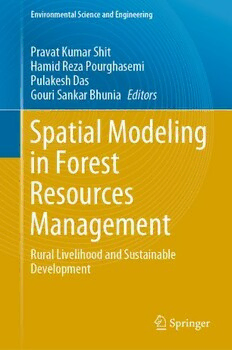
Spatial Modeling in Forest Resources Management : Rural Livelihood and Sustainable Development PDF
Preview Spatial Modeling in Forest Resources Management : Rural Livelihood and Sustainable Development
Environmental Science and Engineering Pravat Kumar Shit Hamid Reza Pourghasemi Pulakesh Das Gouri Sankar Bhunia Editors Spatial Modeling in Forest Resources Management Rural Livelihood and Sustainable Development Environmental Science and Engineering Series Editors Ulrich Förstner, Technical University of Hamburg-Harburg, Hamburg, Germany Wim H. Rulkens, Department of Environmental Technology, Wageningen, The Netherlands Wim Salomons, Institute for Environmental Studies, University of Amsterdam, Haren, The Netherlands More information about this series at http://www.springer.com/series/7487 Pravat Kumar Shit Hamid Reza Pourghasemi (cid:129) (cid:129) Pulakesh Das Gouri Sankar Bhunia (cid:129) Editors Spatial Modeling in Forest Resources Management Rural Livelihood and Sustainable Development 123 Editors PravatKumar Shit HamidReza Pourghasemi PG Departmentof Geography Department ofNatural Resources RajaNarendra Lal KhanWomen’s College andEnvironmental Engineering (Autonomous), Vidyasagar University Collegeof Agriculture, ShirazUniversity Midnapore, West Bengal, India Shiraz, Iran PulakeshDas GouriSankar Bhunia Department ofRemote Sensing&GIS TPFGetinsaEuroestudios S.L. Vidyasagar University Gurgaon,Haryana, India Midnapore, West Bengal, India ISSN 1863-5520 ISSN 1863-5539 (electronic) Environmental Science andEngineering ISBN978-3-030-56541-1 ISBN978-3-030-56542-8 (eBook) https://doi.org/10.1007/978-3-030-56542-8 ©TheEditor(s)(ifapplicable)andTheAuthor(s),underexclusivelicensetoSpringerNature SwitzerlandAG2021 Thisworkissubjecttocopyright.AllrightsaresolelyandexclusivelylicensedbythePublisher,whether thewholeorpartofthematerialisconcerned,specificallytherightsoftranslation,reprinting,reuseof illustrations, recitation, broadcasting, reproduction on microfilms or in any other physical way, and transmissionorinformationstorageandretrieval,electronicadaptation,computersoftware,orbysimilar ordissimilarmethodologynowknownorhereafterdeveloped. The use of general descriptive names, registered names, trademarks, service marks, etc. in this publicationdoesnotimply,evenintheabsenceofaspecificstatement,thatsuchnamesareexemptfrom therelevantprotectivelawsandregulationsandthereforefreeforgeneraluse. The publisher, the authors and the editors are safe to assume that the advice and information in this book are believed to be true and accurate at the date of publication. Neither the publisher nor the authors or the editors give a warranty, expressed or implied, with respect to the material contained hereinorforanyerrorsoromissionsthatmayhavebeenmade.Thepublisherremainsneutralwithregard tojurisdictionalclaimsinpublishedmapsandinstitutionalaffiliations. Disclaimer:Theauthorsofindividualchaptersaresolelyresponsibleforideas,views,data,figures,and geographical boundaries presented in the respective chapters in this book, and these have not been endorsed, in any form, by the publisher, the editor, and the authors of forewords preambles or other chapters. ThisSpringerimprintispublishedbytheregisteredcompanySpringerNatureSwitzerlandAG Theregisteredcompanyaddressis:Gewerbestrasse11,6330Cham,Switzerland Dedicated to beloved teachers and parents Foreword It is a great pleasure to pen the Foreword of the book Spatial Modelling in Forest Management: RuralLivelihood andSustainableDevelopmenteditedbyDr.Pravat Kumar Shit, Dr. Hamid Reza Pourghasemi, Dr. Pulakesh Das, Dr. Gouri Sankar Bhunia. This book is comprised of 28 empirical research articles contributed by dedicated researchers from various disciplines. Thisbookhasbeendividedintothreeparts.Thefirstpartcomprisesninearticles related with forest resource measurements, monitoring systems and mapping techniques. Nine articles of the second part deal with modelling, risk assessment andvulnerability.Thefinalpartwithtenarticlesthrowslightonrurallivelihoodand sustainable management. These 28 research papers encompass in-depth scientific analysis of various socio-economic perspectives offorest resources.Thispublication volume critically analyses the recent trend of forest resource utilisation with particular reference to micro and macro-level issues. Moreover, this book gives emphasis to rural liveli- hood for the sustainable management offorest. Concisely,this bookcoversalmost all the emerging forest-related issues of the present era. vii viii Foreword This book would be a piece of extreme appreciation for researchers, conserva- tionists and social workers. I wish all the very best for its wide circulation and admiration. July 2020 Malay Mukhopadhyay Professor and Former Head Department of Geography Visva-Bharati Santiniketan, India Preface Climatechangeisoneoftheleadingecological,economicalandgeopoliticalissues of the twenty-first century. According to the United Nations Framework Convention on Climate Change (UNFCCC 1992 and IPCC 2007), natural climate variability along with theever-increasinganthropogenic disturbances (via land-use change, deforestation, urban and cropland expansion, increase of artificial surface, use of fossil fuels, exercise of agro-chemicals, etc.) has led to increasing ‘green- house gas’ concentrations in the atmosphere and uprising the average global tem- perature. Forest ecosystem, as a source of huge carbon pool, plays key role in reducing the greenhouse gases and maintaining the water and energy fluxes and regulating the atmospheric processes. To mitigate greenhouse gas effects while maintain the forest ecosystem services, it is essential to provide managers and policymakers with accurate information on the current state, dynamics and spatial distribution of carbon sources and sinks point in forest area. This book has considered 28 chapters associated to spatial modelling in forest resources issues, management and researches on forest health, forest biomass, carbon stocks and climate change studies, preferably. Currently, there are various challenges and uncertainties due of climate change and man-made interferences, which imposes great difficulties in adopting the appropriate decision. On the other hand, suitable management activities and policies for forest conservation have gained much attention globally. The latest advances in geo-spatial (remotesensing [RS] and GIS) technology, data processing platforms and modelling approaches have proven the potentially in developing sustainable and climate adaptive man- agement plans. The integration of various geo-spatial and non-spatial data via advance data processing packages enables to generate reliable data for decision ix x Preface making. Various studies on forest health, forest conservation, carbon stock assessment, non-timber forest resources and climate change mitigation using the evident-based research and supplemented by the latest satellite data and data pro- cessing platforms will contribute to the development of appropriate policy and action plans for sustainable livelihoods. Weareverymuchthankfultoalltheauthorswhohavemeticulouslycompleted theirdocumentsonashortannouncementandpaidinbuildingthisaveryedifying and beneficial publication. We do believe that this will be a very convenient book for the geographers, ecologists, forest scientists and others working in the field of forestresourcesmanagementincludingtheresearchscholars,environmentalistsand policymakers. Midnapore, West Bengal, India Pravat Kumar Shit Hamid Reza Pourghasemi Pulakesh Das Gouri Sankar Bhunia
